#Chandrayaan-2 mission
Explore tagged Tumblr posts
Text
ISRO LANDED CHANDRAYAAN 3 HELL YEAH!!!!!
THE FUCKING SPACESHIP LANDED!!!!
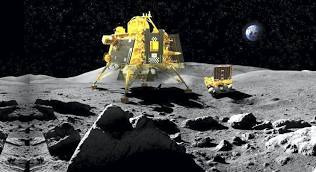
YEAAASSSS CONGRATULATIONS TO INDIA, ISRO AND FELLOW DESIS!!!!!!!
JAI HIND!!!!!
#ISRO#isromoonmission#chandrayaan#chandrayaan3#humanity#CONGRATULATIONS#INDIA#indian moon mission#Holy Shit#hell yeah#INDIA BECAME THE FIRST NATION TO LAND ON SOUTH POLE#tribute to chandrayaan 2#the mission that could#2023#moon landing#Moon rover#vikram#pragyaan#rocket#india#successful moon landing#tw caps#what#desiblr#desi stuff#desi tumblr
166 notes
·
View notes
Text

This is the image of the Indian Chandrayaan 3 lander. Chandrayaan 3 is a follow-up moon exploration mission of Chandrayaan 2. The Chandrayaan 3 was launched on 14th July 2023 and it is expected to land on the moon on 23rd August 2023. A spacecraft or vehicle that is intended to touch down on the surface of a celestial body, such as a planet, moon, or asteroid, is known as a lander. An upgraded version of the Vikram lander from Chandrayaan 2 is present in Chandrayaan 3. It also has four landing thrusters and four landing legs and is box-shaped. The rover and many scientific tools will be aboard for performance in site analysis. If you want to know more about Chandrayaan 3 and its lander, Visit My Article.
5 notes
·
View notes
Text
#chandrayaan 3#chandrayaan 3 launch#chandrayaan 3 launch video#chandrayaan 3 live#chandrayaan 3 mission#chandrayaan 3 mission live#chandrayaan 2 launch video#isro chandrayaan 3#isro#chandrayaan 3 moon landing#chandrayaan 3 news#chandrayaan 3 latest news#isro chandrayaan 3 mission#chandrayaan 3 isro#chandrayaan 3 update live#chandrayaan#chandrayaan 3 update#chandrayaan 3 landing#isro live chandrayaan 3#pm modi on chandrayaan 3#chandrayan launching live
1 note
·
View note
Text
Russia to Launch Lunar Spacecraft in Race to Find Water on Moon Against Chandrayaan-3
Russia made its final preparations on Thursday for the launch of its first lunar landing spacecraft in 47 years as it races to be the first power to make a soft landing on the south pole of the moon which may hold significant deposits of water ice. For centuries, astronomers have wondered about water on the moon, which is 100 times drier than the Sahara. NASA maps in 2018 showed water ice in the…
View On WordPress
#Chandrayaan 3#Chandrayaan- 2#luna-2#lunar mission#russia launch lunar mission race find water on moon against chandrayaan-3 moon
0 notes
Text
Chandrayaan 2: India's Ambitious Lunar Mission
Introduction Chandrayaan 2 is an ambitious space exploration mission conducted by the Indian Space Research Organisation (ISRO). Launched on July 22, 2019, this landmark mission aimed to explore the uncharted territories of the moon and expand our understanding of Earth’s celestial neighbor. In this article, we will delve into the key aspects and achievements of Chandrayaan 2, highlighting its…

View On WordPress
#Chandrayaan 2#impact#India#ISRO#lunar mission#lunar surface#mineral composition#moon exploration#scientific instruments#space program#water ice
1 note
·
View note
Text
Since some of y'all do not know how to celebrate our achievements in space exploration:
Facts:
1) India became the 5th ever country to reach the moon surface back in 2008 with Chandrayaan-1.
2) India is the 1st ever country to soft-land the south pole of the moon and 4th country to soft-land on moon.
3) India has never physically placed a flag on moon- Only USA and China have physical flags on moon. 'Having a flag on moon' is said as a way to signify a country's presence on the moon through a mission.
Now from all the reactions I have seen, I can categorise them as follows:
1) Space enthusiasts: (Indians and non Indians) Wow! We have a rover in the south pole of moon now! For the first time ever! So proud.
2) Jingoists: YAYyyyy....India is has joined the group of the big bad countries with expensive space missions. Now we are in the same category as those countries who are known for their imperialism and power in world politics bahahahah. WE ARE ONE OF THEM (Modi hai mumkin hai)
3) H!ndu nat!onalists: "SomE coUnTrIeS hAvE FlAgs oN mOoN, oTHerS hAvE MooNs iN fLAgS". (Modi hai toh mumkin hai)
(2) and (3) are actively disrespecting the scientists, engineers and the whole team which made this possible, Out of their love for science and exploration and hard work to make this dream, People have had for decades, come true. They did not do this for small minded nationalism and religious politics.
Moving slightly away from the topic, Y'all were cheering for our Olympic wrestlers when they came home with medals and were very 'proud' of them. Same type of nationalistic things were said. But then y'all abandoned them, Even called them traitors, when they protested against a powerful BJP politician who was sexually harassing minors and women for several years. They asked for support and were met with ridicule. Till this date that person is roaming around free with only a non existent chance of holding him accountable.
So if you're proud of ISRO because y'all got to be jingoists and religious supremacists for a day then you may as well shut up and go back to school. This wasn't for YOU.
232 notes
·
View notes
Note
hiii
not sure if you're interested but india launched chandrayaan- 3 (mission to the moon) today (july 14 at 2:35 pm ist).
and it is led by a woman!!! her name is ritu karidhal srivastava.
she also had a very major role in the development of mangalyaan (the indian mars orbiter mission)
it is exciting because well it's my country, and a woman!!
moreover, she is a batchmate of my aunt, and although i dont know her personally it is very very surreal to know that a woman this close to my knowns, has achieved such a great feat!!
(also very inspiring because i am working my way there too, as we speak)
hoping for successful mission 🤞🏽
so yeah really exciting!! hope you dont mind this message
much love and success to you!!!
That is so exciting!!! I’m so glad you shared that with me, I’ve been out of it the past few days (medication from surgery doesn’t agree with me) and I completely missed news about this. I hope it is very successful and will definitely read more about it when I’m with it a little more :)
46 notes
·
View notes
Text
From the Moon’s south pole to an ice-covered ocean world, several exciting space missions are slated for launch in 2024
by Ali M. Bramson, Assistant Professor of Earth, Atmospheric, and Planetary Sciences at Purdue University
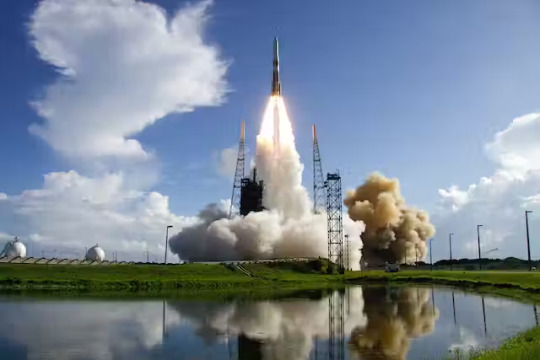
The year 2023 proved to be an important one for space missions, with NASA’s OSIRIS-REx mission returning a sample from an asteroid and India’s Chandrayaan-3 mission exploring the lunar south pole, and 2024 is shaping up to be another exciting year for space exploration.
Several new missions under NASA’s Artemis plan and Commercial Lunar Payload Services initiative will target the Moon.
The latter half of the year will feature several exciting launches, with the launch of the Martian Moons eXploration mission in September, Europa Clipper and Hera in October and Artemis II and VIPER to the Moon in November – if everything goes as planned.
I’m a planetary scientist, and here are six of the space missions I’m most excited to follow in 2024.
1. Europa Clipper
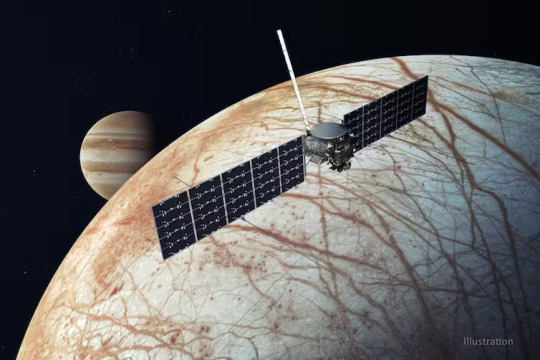
NASA will launch Europa Clipper, which will explore one of Jupiter’s largest moons, Europa. Europa is slightly smaller than Earth’s Moon, with a surface made of ice. Beneath its icy shell, Europa likely harbors a saltwater ocean, which scientists expect contains over twice as much water as all the oceans here on Earth combined.
With Europa Clipper, scientists want to investigate whether Europa’s ocean could be a suitable habitat for extraterrestrial life.
The mission plans to do this by flying past Europa nearly 50 times to study the moon’s icy shell, its surface’s geology and its subsurface ocean. The mission will also look for active geysers spewing out from Europa.
This mission will change the game for scientists hoping to understand ocean worlds like Europa.
The launch window – the period when the mission could launch and achieve its planned route – opens Oct. 10, 2024, and lasts 21 days. The spacecraft will launch on a SpaceX Falcon Heavy rocket and arrive at the Jupiter system in 2030.
2. Artemis II launch

The Artemis program, named after Apollo’s twin sister in Greek mythology, is NASA’s plan to go back to the Moon. It will send humans to the Moon for the first time since 1972, including the first woman and the first person of color. Artemis also includes plans for a longer-term, sustained presence in space that will prepare NASA for eventually sending people even farther – to Mars.
Artemis II is the first crewed step in this plan, with four astronauts planned to be on board during the 10-day mission.
The mission builds upon Artemis I, which sent an uncrewed capsule into orbit around the Moon in late 2022.
Artemis II will put the astronauts into orbit around the Moon before returning them home. It is currently planned for launch as early as November 2024. But there is a chance it will get pushed back to 2025, depending on whether all the necessary gear, such as spacesuits and oxygen equipment, is ready.
3. VIPER to search for water on the Moon
youtube
VIPER, which stands for Volatiles Investigating Polar Exploration Rover, is a robot the size of a golf cart that NASA will use to explore the Moon’s south pole in late 2024.
Originally scheduled for launch in 2023, NASA pushed the mission back to complete more tests on the lander system, which Astrobotic, a private company, developed as part of the Commercial Lunar Payload Services program.
This robotic mission is designed to search for volatiles, which are molecules that easily vaporize, like water and carbon dioxide, at lunar temperatures. These materials could provide resources for future human exploration on the Moon.
The VIPER robot will rely on batteries, heat pipes and radiators throughout its 100-day mission, as it navigates everything from the extreme heat of lunar daylight – when temperatures can reach 224 degrees Fahrenheit (107 degrees Celsius) – to the Moon’s frigid shadowed regions that can reach a mind-boggling -400 F (-240 C).
VIPER’s launch and delivery to the lunar surface is scheduled for November 2024.
4. Lunar Trailblazer and PRIME-1 missions

NASA has recently invested in a class of small, low-cost planetary missions called SIMPLEx, which stands for Small, Innovative Missions for PLanetary Exploration. These missions save costs by tagging along on other launches as what is called a rideshare, or secondary payload.
One example is the Lunar Trailblazer. Like VIPER, Lunar Trailblazer will look for water on the Moon.
But while VIPER will land on the Moon’s surface, studying a specific area near the south pole in detail, Lunar Trailblazer will orbit the Moon, measuring the temperature of the surface and mapping out the locations of water molecules across the globe.
Currently, Lunar Trailblazer is on track to be ready by early 2024.
However, because it is a secondary payload, Lunar Trailblazer’s launch timing depends on the primary payload’s launch readiness. The PRIME-1 mission, scheduled for a mid-2024 launch, is Lunar Trailblazer’s ride.
PRIME-1 will drill into the Moon – it’s a test run for the kind of drill that VIPER will use. But its launch date will likely depend on whether earlier launches go on time.
An earlier Commercial Lunar Payload Services mission with the same landing partner was pushed back to February 2024 at the earliest, and further delays could push back PRIME-1 and Lunar Trailblazer.
5. JAXA’s Martian Moon eXploration mission
youtube
While Earth’s Moon has many visitors – big and small, robotic and crewed – planned for 2024, Mars’ moons Phobos and Deimos will soon be getting a visitor as well. The Japanese Aerospace Exploration Agency, or JAXA, has a robotic mission in development called the Martian Moon eXploration, or MMX, planned for launch around September 2024.
The mission’s main science objective is to determine the origin of Mars’ moons. Scientists aren’t sure whether Phobos and Deimos are former asteroids that Mars captured into orbit with its gravity or if they formed out of debris that was already in orbit around Mars.
The spacecraft will spend three years around Mars conducting science operations to observe Phobos and Deimos. MMX will also land on Phobos’ surface and collect a sample before returning to Earth.
6. ESA’s Hera mission

Hera is a mission by the European Space Agency to return to the Didymos-Dimorphos asteroid system that NASA’s DART mission visited in 2022.
But DART didn’t just visit these asteroids, it collided with one of them to test a planetary defense technique called “kinetic impact.” DART hit Dimorphos with such force that it actually changed its orbit.
The kinetic impact technique smashes something into an object in order to alter its path. This could prove useful if humanity ever finds a potentially hazardous object on a collision course with Earth and needs to redirect it.
Hera will launch in October 2024, making its way in late 2026 to Didymos and Dimorphos, where it will study physical properties of the asteroids.
7 notes
·
View notes
Text
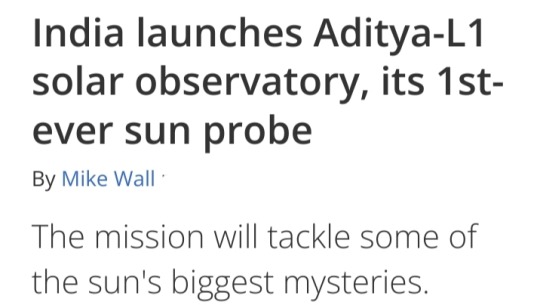
2 September 2022
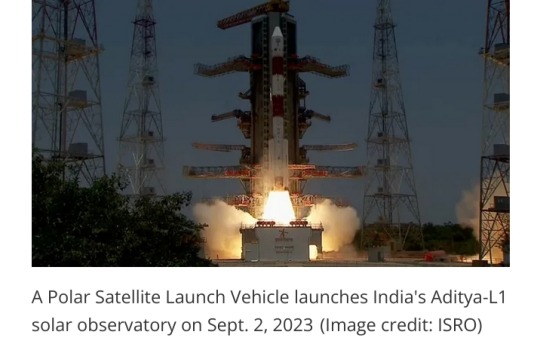
Fresh off its success at the moon, India is now headed for the sun.
The nation launched its first-ever solar observatory today (Sept. 2), sending the Aditya-L1 probe skyward atop a Polar Satellite Launch Vehicle (PSLV) from Satish Dhawan Space Centre at 2:20 a.m. EDT (0620 GMT; 11:50 a.m. local India time).
The PSLV deployed Aditya-L1 into low Earth orbit (LEO) as planned about 63 minutes after liftoff, sparking applause and high fives in mission control.
"Congratulations, India, and congratulations, ISRO [the Indian Space Research Organisation]," Jitendra Singh, India's Minister of State for Science and Technology, said shortly after deployment on ISRO's launch webcast.
"While the whole world watched this with bated breath, it is indeed a sunshine moment for India," Singh added.
The successful launch followed on the heels of another big milestone for India: On August 23, its Chandrayaan-3 mission became the first to land softly near the moon's south pole.
Chandrayaan-3's lander-rover duo are expected to conk out in a week or so, when the harsh lunar night falls at their touchdown site. But Aditya-L1's long journey has just begun.
A long road to a good sun-viewing spot
Aditya-L1 won't stay in LEO forever:
After a series of checkouts, it will use its onboard propulsion system to head toward Earth-sun Lagrange Point 1 (L1), a gravitationally stable spot about 1 million miles (1.5 million kilometers) from our planet in the direction of the sun.
That destination explains the latter part of the mission's name. And the first part is simple enough: "Aditya" translates to "sun" in Sanskrit.
The 3,260-pound (1,480 kilograms) observatory will arrive at L1 about four months from now, if all goes according to plan.
But the long trek will be worth it, according to the ISRO.
"A satellite placed in the halo orbit around the L1 point has the major advantage of continuously viewing the sun without any occultation/eclipses," ISRO officials wrote in an Aditya-L1 mission description.
"This will provide a greater advantage of observing the solar activities and its effect on space weather in real time."
Indeed, another sun-studying spacecraft is already at L1 — the Solar and Heliospheric Observatory (SOHO), a joint NASA-European Space Agency mission that launched in December 1995.
(Several other spacecraft, including NASA's James Webb Space Telescope, are at Earth-sun Lagrange Point 2, which is a million miles from Earth, in the direction away from the sun.)

Solar flares, the coronal heating mystery and more
Once it's settled in at L1, the solar probe will use four three science instruments to study the particles and magnetic fields in its immediate surroundings and four others to scrutinize the sun's surface (known as the photosphere) and its atmosphere.
This work will help scientists better understand solar activity, including the dynamics of solar flares and coronal mass ejections (CMEs), ISRO officials say.
Flares are powerful flashes of high-energy radiation, and CMEs are huge eruptions of solar plasma.
Both types of outburst can affect us here on Earth. Intense CMEs that hit our planet, for example, trigger geomagnetic storms that can disrupt satellite navigation and power grids.
(As a side benefit, such storms also supercharge the gorgeous light shows known as auroras.)
Aditya-L1 will also tackle the "coronal heating problem," one of the biggest mysteries in heliophysics.
The corona — the sun's wispy outer atmosphere — is incredibly hot, reaching temperatures around 2 million degrees Fahrenheit (1.1 million degrees Celsius), according to NASA.
That's about 200 times hotter than the solar surface, which is "only" 10,000 degrees F (5,500 degrees C) or so.
It's still unclear what is responsible for this startling and counterintuitive discrepancy.
(Why would it be hotter away from the sun's core, where the energy-producing nuclear fusion reactions are occurring?)
Aditya-L1 has other science goals as well. For instance, the mission also aims to more fully flesh out the solar wind, the stream of charged particles flowing constantly from the sun, ISRO officials said.
Aditya-L1 will measure the composition of the solar wind and attempt to determine how it is accelerated.
And Aditya-L1 will do all this work on the cheap:
The mission's price tag is about 3.8 billion rupees, or $46 million US at current exchange rates.
That's in the same ballpark as Chandrayaan-3
India's first successful moon-landing mission costs about 6.15 billion rupees, or $74 million US.
For comparison, NASA's most recent big-ticket sun mission, the record-setting Parker Solar Probe, costs roughly $1.5 billion.
This disparity should not be viewed as an indictment of NASA, however; labor costs are much higher in the United States than in India, among other differences between the two nations' economies.
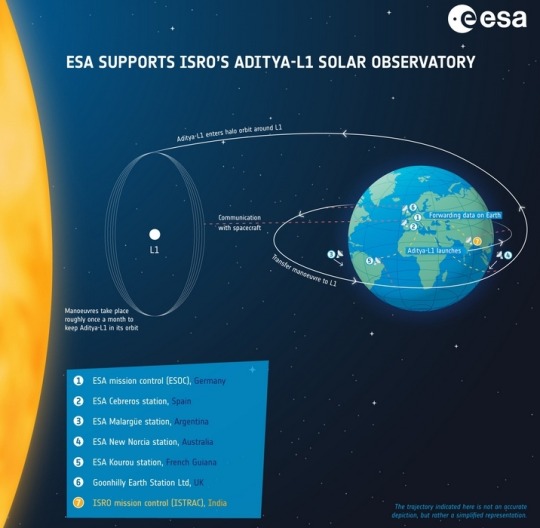
Aditya-L1 is a coronagraphy spacecraft to study the solar atmosphere, designed and developed by the Indian Space Research Organisation (ISRO) and various other Indian research institutes.
#India#Aditya-L1#Polar Satellite Launch Vehicle (PSLV)#Satish Dhawan Space Centre#low Earth orbit (LEO)#sun#Indian Space Research Organisation#Chandrayaan-3#Earth-sun Lagrange Point 1 (L1)#Solar and Heliospheric Observatory (SOHO)#solar flares#coronal mass ejections (CMEs)#coronal heating problem#heliophysics#solar wind#Parker Solar Probe#NASA#solar observatory#solar atmosphere
13 notes
·
View notes
Text
Big News !!

1. Donald Trump arrested. It's a first for any US President! Hooray on the iconic achievement! He got booked at a Georgia jail on racketeering charges and had a sexy mugshot taken. He got out around 20 minutes after surrendering because he paid the bail amount.

2. Yevgeny Prighozin "death". Apparently a plane with him and 10 other people crash landed in Russia, and he's now presumed dead. He was a far right dude who rebelled against Putin because he didn't get enough leeway from him to be an asshole. He called off the march after a day. Two months later, he's dead. Go figure.

3. Chandrayaan-3 Success. They succeeded in soft landing on the South Pole of the moon, making them the first country to land on the South Pole and the fourth country to land a rover mission on the moon. It's the successor of the Chandrayaan-2 and the lander is named Vikram, while the Rover is named Pragyan. They focused on giving it more fuel than the previous mission in 2019 to allow for greater spin, and also used the images from the failed mission to aid the landing of the Chandrayaan-3.
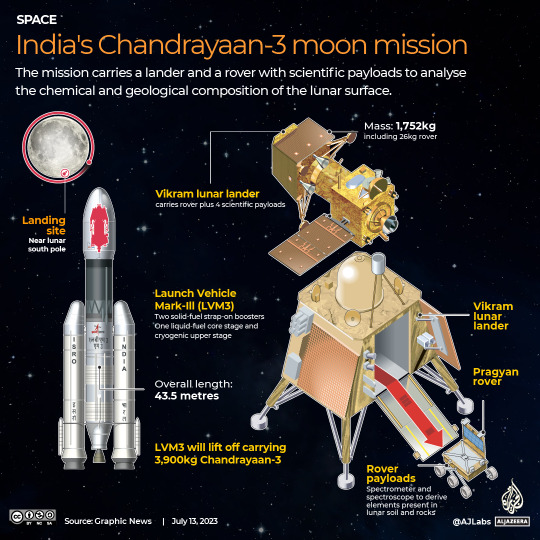
Sorry for being a pesky news anchor, I just couldn't hold it in because of the barrage of news I've been bombarded with this week. A lot of interesting developments recently.
#donald trump#donald trump arrest#yevgeny prigozhin#wagner group#russia#chandrayaan3#chandrayaanlaunch#chandrayaan isro#isromoonmission#isro#chandrayaan 3#chandrayaanlanding#news coo#big news morgans#destiel#georgia#history#us politics#trump indictment
12 notes
·
View notes
Text

The image of Indian Chandrayaan 3 before launch on 14 July 2023. Chandrayaan 3 is an Indian space exploration mission that aims to explore the moon. The Chandrayaan 3 is a follow-up of Chandrayaan 2. The mission is still in progress and is expected to land on the moon on 23 August 2023. If you want to know more about Chandrayaan 3, Visit My Article.
2 notes
·
View notes
Text
Chandrayaan-3's Historic Fifth Orbit-Raising Maneuver: A Giant Leap Closer to the Moon

July 22, 2023 - India's tryst with lunar exploration is on the verge of reaching new heights as the Indian Space Research Organisation (ISRO) prepares for the fifth orbit-raising maneuver of the Chandrayaan-3 spacecraft. With this remarkable feat scheduled to take place on July 25 between 2 pm and 3 pm IST, ISRO is poised to propel Chandrayaan-3 even closer to the Moon, marking a historic step in the nation's journey of scientific discovery.
Chandrayaan-3's Momentous Odyssey
From its awe-inspiring launch at the Satish Dhawan Space Centre in Sriharikota to its remarkable propulsion through space, Chandrayaan-3's journey has captivated the world's attention. Designed to explore the lunar surface and conduct in-depth scientific research, the spacecraft represents India's unwavering commitment to space exploration.
Anticipation Builds for the Fifth Orbit-Raising Maneuver
The upcoming fifth orbit-raising maneuver is the next crucial phase in Chandrayaan-3's mission. Scheduled to occur on July 25, between 2 pm and 3 pm IST, this meticulously planned event will involve precision-thruster firings to increase the spacecraft's orbital altitude. ISRO's team of dedicated engineers and scientists have worked tirelessly to ensure the success of this critical operation.
Read full article here
14 notes
·
View notes
Text
The Chandrayaan 3
CHANDRAYAAN-3
Greetings to everyone who is reading this blog.
Recently the big achievement, India made history by landing on the moon's south pole surface with a smooth landing.
India has become the only country to have ever done so. There is a machine called the rover whose name is Pragyan which is a small vehicle meant to roam on the surface of the moon to check the soil condition water pressure etc.
This mission was only successful because ISRO kept persisting they learned from the past 2 missions that is [ Chandrayaan -1 & Chandrayaan 2 ].
To smoothly land on the moon's south pole is difficult cause the terrain and temperature are not suitable the temperature at the south pole is too cold.
The spacecraft entered the lunar surface on August 5. The lunar South Pole region holds particular interest for scientific exploration due to studies that show large amounts of ice there. This ice could contain solid-state compounds that would normally melt under warmer conditions elsewhere on the Moon, compounds which could provide insight into lunar, Earth, and Solar System history.
This ice will help us know more about how the whole solar system was formed. Ice could also be used as a source of drinking water and hydrogen for fuel and oxygen.
There were 3 main objectives of Chandrayan 3
Getting a lander to land safely and softly on the surface of the Moon.
Observing and demonstrating the rover's driving capabilities on the Moon.
Conducting and observing experiments on the materials available on the lunar surface to better understand the composition of the Moon. ISRO has said by the end of the year we will get to know if human life is possible on earth and much relevant information as such.
In December 2019, ISRO requested the initial funding of the project, amounting to ₹75 crore. Amit Sharma, CEO of an ISRO vendor, said, "With local sourcing of equipment and design elements, we can reduce the price considerably."
That is it for the day Hope we see more such missions of ISRO successful and we Indians Reach the height.
9 notes
·
View notes
Text


I missed the information about the Chandrayaan 2 mission but following the Chandrayaan 3 mission has been an incredible experience and I am so proud of my country. Even with so much working against us and most of the world believing we are reaching higher than we should, we persevered.
My biggest congratulations to ISRO and to the scientists, I salute you for your hard work. You have made your mark in history, and it is richly deserved.
We've reached the moon, now let's go to the stars!
Congratulations Chandrayaan 3! 🥳🥳🎉🎉
10 notes
·
View notes
Text
I was glued to the TV for like 2 hours during the whole landing processions and my breath was stuck in my throat as if I was the mission director or what 😂😂 but the relief I got when this one didn't end up like the Chandrayaan - 2 one was amazing.
#chandrayaan3#the landing was celebrated like a festival#everyone was watching the live telecast#and schools were opened#and it was made compulsory to watch the landing for students by the DM#india
9 notes
·
View notes
Text

I will always be enamored by the fact that one of our space critters is roaming around on the moon while I gaze at it.
Chandrayaan 3 was a huge success. How did I confirm this? We heard firecrackers and cheers late into the night.
An astonishing feat, and one expected from the desi scientists, is this missions compact budget. A mere $75 million. While ISRO is receiving well-deserved recognition for this caveat, the institution highlights its contributors in the article "The Making of Chandrayaan-3: collaborative effort under the 'ISRO culture'."
They further explain making major improvements in the Lander of the spacecraft based on the violent landing that destroyed Chandrayaan-2. Leaving no room for failure this time, Chandrayaan-3 left Earth with a lander, "with the capabilities to autonomously handle wider range of dispersion, improvements in sensors, software and propulsion systems, full level redundancies in addition to exhaustive simulations and additional tests being conducted towards ensuring a higher degree of ruggedness in the lander."
The success of this mission showed more than ISRO's grit and intelligence. It showed the magic of generous collaboration between institutions and the human beings running them on their endeavor into something so much greater than themselves. However, this is the tip of the iceberg, and in the years to come, I hope nations around the world can collaborate in even harmonious ways for sustainable progress and humanity's greater good on Earth and in space.
7 notes
·
View notes